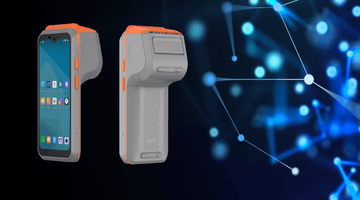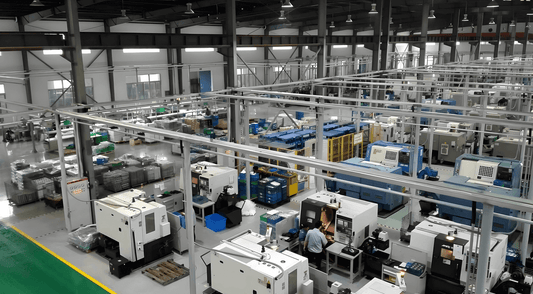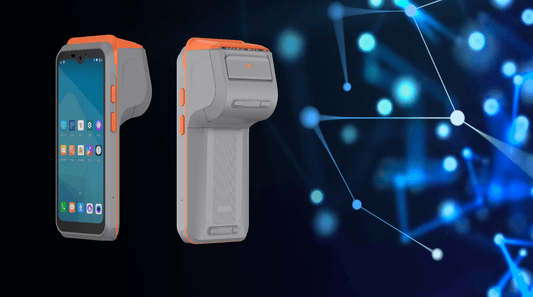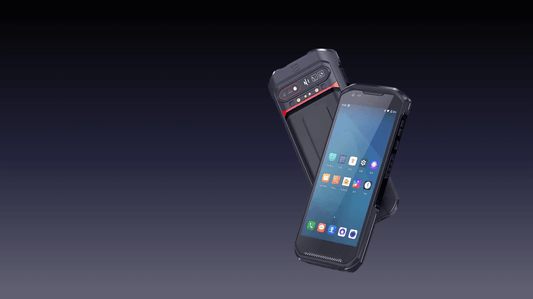LS-HC720S Handheld RFID: Revolutionizing Inventory Efficiency for an Auto Parts Company
In the automotive parts manufacturing industry, inventory accuracy and supply chain responsiveness directly determine a company's competitiveness. However, for Xinyuan Auto Parts Co., Ltd. (hereinafter referred to as "Xinyuan"), with an annual production capacity of 3 million units and over 2,000 warehouse SKUs, these core requirements were hampered by traditional inventory management models until the introduction of the LS-HC720S handheld RFID device and its integration with its ERP and inventory systems. This article details how the LS-HC720S addressed Xinyuan's inventory pain points and became a key component of system integration.
1. Case Background: Xinyuan’s Inventory Problem
Xinyuan primarily supplies engine parts to major domestic automakers. It operates two temperature-controlled warehouses (totaling 8,000 square meters), storing components ranging from metal castings to electronic sensors. 80% of these goods require labeling for batch and expiration date traceability. Prior to 2023, Xinyuan employed a "manual inventory + standard barcode scanner" management model, utilizing both UFIDA U9 Cloud ERP and Kingdee K/3 WISE inventory systems. However, the two systems were not fully integrated, leading to the emergence of three core pain points:
1. Inefficient inventory management affects production scheduling
The monthly inventory requires six employees to carry barcode guns and scan each item, which takes three days. During this period, the warehouse needs to suspend some inbound and outbound operations, causing the production department to stop work 2-3 times per month due to "waiting for materials." In the case of urgent orders, temporary inventory requires two people and takes eight hours, seriously slowing down the delivery rhythm.
2. Data lag leads to "double waste"
Data collected by the barcode scanner must be manually exported to Excel and then imported into the inventory system before being synchronized with the ERP the next day. In the fourth quarter of 2022, Xinyuan experienced two errors due to lagging inventory data: First, there were only 50 sensors in stock, but the ERP showed 150, causing the production department to stop production as planned for four hours; second, due to duplicate data entry for a certain casting, 300 more units were purchased, tying up over 200,000 yuan in capital.
3. Equipment "failure" in complex environments
The warehouse is densely populated with metal shelves (accounting for 60%), and some parts are stored on anti-static pallets. Ordinary barcode guns are easily interfered with by metal, with a reading success rate of only 85%. Employees need to repeatedly adjust the scanning angle, further increasing their workload. At the same time, the logistics channel between the workshop and the warehouse is dusty, and the barcode gun casing is easily worn. On average, one barcode gun needs to be replaced every six months, resulting in high equipment maintenance costs.
2. Solution: "Device + System" Integration Solution with LS-HC720S as the Core
At the beginning of 2023, Xinyuan selected the LS-HC720S handheld RFID device after research and worked with a technical service provider to complete the integration with the ERP and inventory systems. The core of the solution revolved around "device adaptation scenario + real-time data flow":
1. Why choose LS-HC720S? Three key features that match your needs
During the testing phase, Xinyuan compared three similarly priced RFID devices and ultimately chose the LS-HC720S. The key reason was that its features were highly compatible with enterprise scenarios:
• Anti-interference capabilities make it suitable for complex environments : It supports the ultra-high frequency (UHF) band and is equipped with a self-developed anti-metal antenna. The reading success rate reaches 99.8% in areas with dense metal shelves, solving the problem of barcode guns "not being able to scan". The device also meets the IP67 protection standard, and dust and minor water stains have no effect on its use. It can be shared between workshops and warehouses, eliminating the need to purchase additional dedicated equipment.
• Batch reading + long battery life improves efficiency : 120 RFID tags can be identified at a time (covering a radius of 1.5-3 meters), which is 10 times more efficient than the "item-by-item scanning" of barcode guns; the built-in 5000mAh battery can be used continuously for 8 hours when fully charged, meeting the warehouse's all-day inventory needs without the need for charging.
• Compatibility ensures system docking : LS-HC720S supports Android 11 system, provides standard USB-C and Wi-Fi 6 interfaces, and can be directly connected with Xinyuan's existing UFIDA U9 Cloud ERP and Kingdee K/3 WISE inventory systems through API interfaces, without the need to modify the original system architecture, reducing integration costs.
2. Integration Implementation: Achieving Real-Time Data Synchronization in Four Steps
To ensure seamless integration of the LS-HC720S with the system, Xinyuan completed the implementation in four months. The specific steps are as follows:
• Step 1: Label transformation (1 month)
Replace all parts with UHF RFID tags (with built-in unique ID codes, associated batch, expiration date, and supplier information), and complete the "tag ID - cargo information" binding in the inventory system to ensure that the LS-HC720S can automatically match the cargo details after reading.
• Step 2: Device debugging and interface development (2 weeks)
The technical team installed a customized inventory management app in the LS-HC720S and connected the device with the Kingdee inventory system through an API interface: the tag data collected by the device is uploaded to the inventory system in real time via Wi-Fi 6, and the inventory system then synchronizes the data to UFIDA ERP through middleware (Apache Kafka), realizing a three-level data flow of "device-inventory system-ERP", with the delay controlled within 10 seconds.
• Step 3: Staff training (2 weeks)
Warehouse managers received two phases of training: the first (theoretical) phase covered the LS-HC720S's operational logic (e.g., power-up, tag reading, and exception handling) and system integration principles; the second (practical) phase simulated inventory, warehousing, and outbound delivery scenarios in a small area (a 500-square-meter warehouse), ensuring that employees could independently complete the entire "device scanning - data verification - exception feedback" process. Ultimately, all 12 warehouse employees passed the assessment, achieving an operational proficiency level exceeding 95%.
• Step 4: Pilot and full-scale promotion (1.5 months)
The pilot program ran for one month in Warehouse 1, addressing two issues: first, adjusting the LS-HC720S's reading sensitivity to prevent misreading of labels on adjacent shelves; and second, optimizing the ERP data display interface and adding a "Real-Time Inventory Alert" module (which automatically pops up when inventory falls below a safe threshold). Following the successful pilot, the full rollout was completed in Warehouse 2 within a month.
Implementation Results: Data Witnesses Efficiency Transformation
As of the end of 2023, the LS-HC720S integrated solution has been running stably in Xinyuan for 10 months, with all indicators exceeding expectations. The specific results can be reflected in three aspects: "efficiency, cost, and decision-making":
1. Inventory efficiency increased by 92%, and production interruption rate dropped to 0
Monthly inventory has been compressed from "6 people and 3 days" to "2 people and 2.5 hours" without suspending warehouse operations; temporary emergency inventory (such as when a certain component is urgently needed for production) only takes 1 person and 30 minutes to complete. In the second half of 2023, there will be no more production interruptions caused by "unclear inventory data", and the delivery on-time rate will increase from 88% to 99.5%.
2. Labor and equipment costs are both reduced, and inventory accuracy exceeds 99.7%.
Warehouse labor costs were reduced by 50% (from 12 to 6 employees, with the remaining staff transferred to production support positions). Equipment maintenance costs were reduced by 70%. The LS-HC720S has operated trouble-free for 10 months without wear or malfunction, replacing the barcode scanners that were previously replaced every six months (saving approximately 30,000 yuan in equipment costs annually). Furthermore, the inventory data error rate dropped from 8% to below 0.3%. There were no more instances of overstocking or out-of-stock shutdowns in 2023, and inventory turnover days were shortened from 45 days to 28 days, freeing up approximately 1.5 million yuan in capital.
3. Accelerate supply chain collaboration and make decisions more accurate
Suppliers can view Xinyuan's parts inventory and consumption rate in real time through ERP authorized accounts: when the inventory of a certain casting is lower than the safety threshold (such as 50 pieces), the supplier can automatically arrange replenishment, and the replenishment cycle is shortened from 15 days to 7 days; Xinyuan's management can use ERP's "inventory dynamic report" to grasp the inventory turnover rate and expiration status of each component in real time. In 2023, the loss rate of expiring parts will be reduced from 10% to 2%, reducing waste by approximately 80,000 yuan.
IV. Case Summary: Enlightenment from the “Integration Value” of LS-HC720S
Xinyuan's case proves that the value of handheld RFID devices lies not only in "efficient data collection" but also in becoming the "terminal hub of system integration" - the LS-HC720S, with its "scenario adaptability + high compatibility", not only solves the "failure" problem of traditional equipment in complex environments, but also enables "real-time data" to truly serve production, procurement and supply chain decision-making through linkage with ERP and inventory systems.
For similar manufacturing companies (especially those with many inventory SKUs and complex environments), Xinyuan's experience can be reused in two points: First, when selecting RFID equipment, priority should be given to "anti-interference ability, battery life, and system compatibility" rather than just looking at parameters; second, integrated implementation needs to be "progressed in steps", and the compatibility of equipment and systems should be verified through pilot projects, and then gradually promoted to reduce implementation risks.
As Xinyuan's supply chain director said, "The LS-HC720S is more than just a simple barcode scanning device. It's a key tool that enables us to shift our inventory management from 'passive gap filling' to 'active control'. When the data collected by the device can be synchronized with the ERP in real time, every department can obtain 'trusted inventory data'. This is the true meaning of integration."
No comments










0 comments